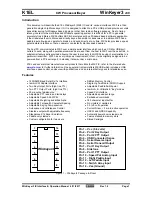
5.21 Alarm functions
5.21.1 General
The application uses 2 different alarm classes:
●
An A-Alarm indicated an important and urgent situation. If an A-Alarm is
triggered, the unit shuts down. An A-Alarm must be acknowledged and can
only be reset after cause of alarm is eliminated.
●
A B-Alarm indicates a less urgent maintenance incident and during active B-
alarm, the unit runs either normally or is still in acceptable condition to run
(without major problems).
The installer can configure alarm for certain errors and can choose between A-
Alarm, B-Alarm or no alarm.
Alarms must be acknowledged and as soon as the cause for each alarm is
eliminated , normal operation is resumed. If one or more reasons still exist,
acknowledgement does not reset that specific alarm and operation might not
continue normally.
All alarms are shown with a time stamp and entry to non volatile storage for each
“change of state”.
Alarm states
5 different alarm states are used in the application and they are valid for both A
and B-Alarms. These different states are meant to give additional information for
different users and different situations. Relay operation is depending on actual
configuration.
State
Situation
Alarm relay
Normal
Everything works normally
Open
Alarm, unacknowledged
Problem detected by controller and alarm activated (e.g.
new alarm)
Closed
Alarm, acknowledged
Problem still existing, service man acknowledged the
active alarm
Open
Normal, acknowledged
Problem fixed / eliminated, alarm is acknowledged.
●
For A-Alarm: Reset pending to unlock unit.
●
For B-Alarm: Works normal.
Open
Normal, unacknowledged
Problem fixed / eliminated, but alarm is not
acknowledged
Closed
In the case of critical A-Alarms, the application operation is locked in shut down
mode until the alarm is acknowledged and reset.
Application functionalities
Alarm functions
5
A6V10733786_en_c
135 | 170
















































